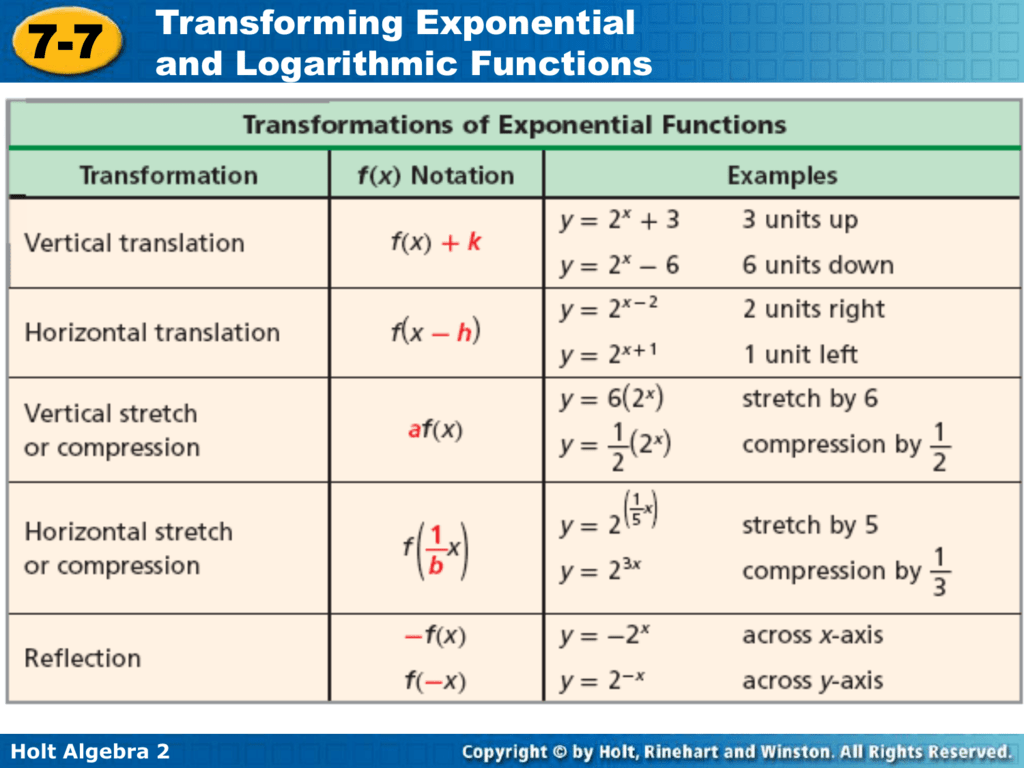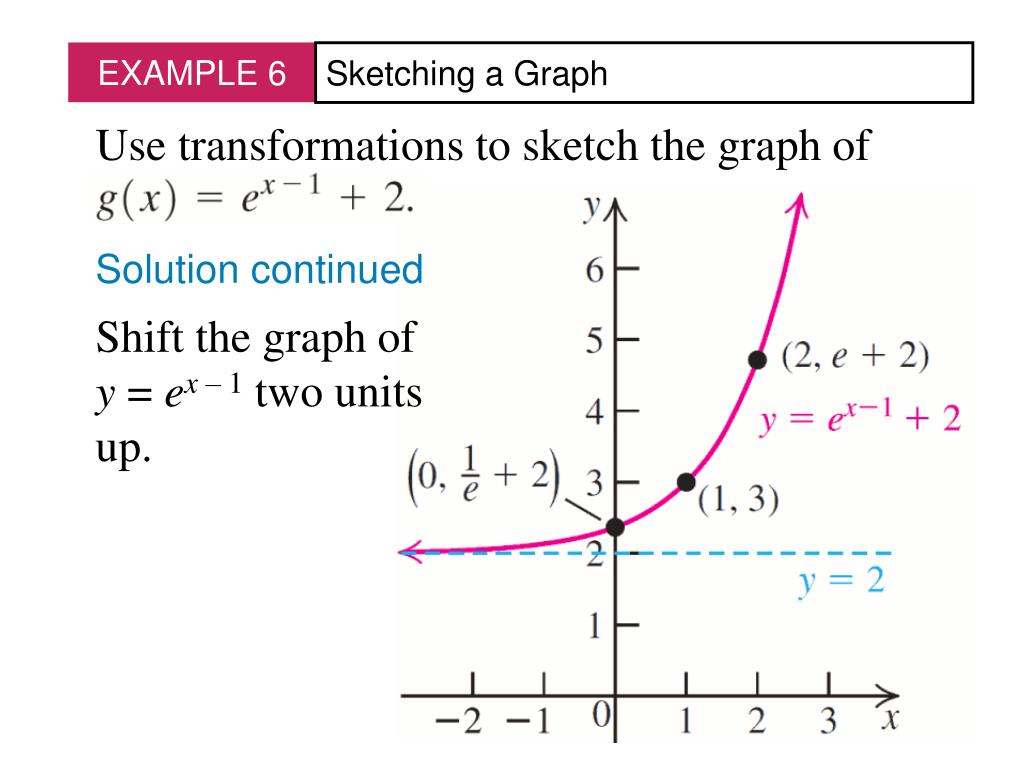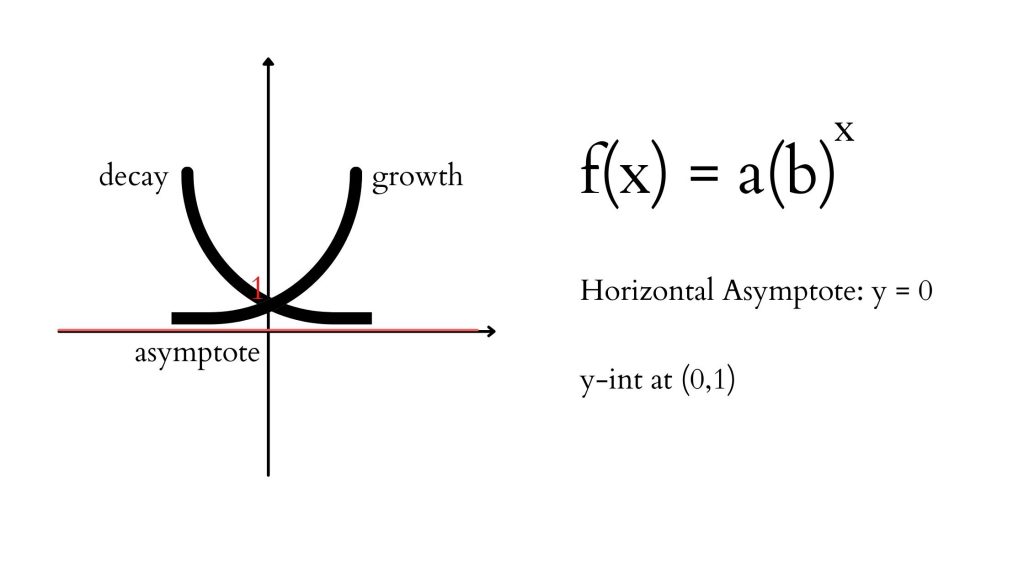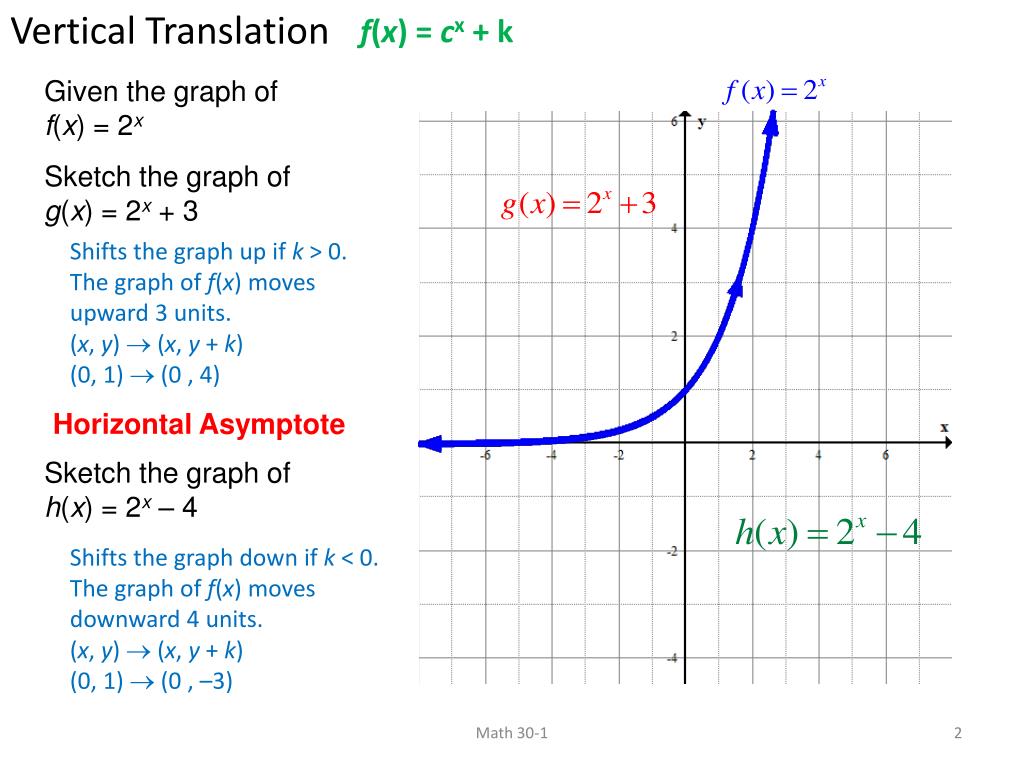Describe Transformation of Exponential Function MCR3U GCSE IBSL YouTube

Transformations Exponential Function YouTube
Transformations and Applications. Exponential functions are functions that model a very rapid growth or a very rapid decay of something. They are used to calculate finances, bacteria populations, the amount of chemical substance and much more. In the exponential function the input is in the exponent. The base of the power determines whether the.

PPT exponential functions PowerPoint Presentation, free download ID
Graphs of exponential functions © 2024 Khan Academy Terms of use Privacy Policy Cookie Notice Transforming exponential graphs (example 2) Google Classroom About Transcript Given the graph of y=2ˣ, Sal graphs y= (-1)2ˣ⁺³+4, which is a vertical reflection and a shift of y=2ˣ. Questions Tips & Thanks Want to join the conversation? Sort by: Top Voted

PPT 3B Transformations of Exponential Functions PowerPoint
Graph exponential functions using transformations. As we discussed in the previous section, exponential functions are used for many real-world applications such as finance, forensics, computer science, and most of the life sciences. Working with an equation that describes a real-world situation gives us a method for making predictions.

Transforming Exponential and Logarithmic Functions
Transformations of exponential graphs behave similarly to those of other functions. Just as with other parent functions, we can apply the four types of transformations—shifts, reflections, stretches, and compressions—to the parent function \displaystyle f\left (x\right)= {b}^ {x} f (x) = bx without loss of shape.

Intro Graphing Transformation with Exponential Functions YouTube
This algebra 2 and precalculus video tutorial focuses on graphing exponential functions with e and using transformations. It explains how to find and write the domain and range of the.

Algebra Lesson 65 Transformations of Exponential Functions YouTube
D: Graph Shifts of Exponential Functions. Exercise 4.2e. D. ★ In the following exercises, use transformations to graph each exponential function. State the transformations that must be done to the parent function in order to obtain the graph. 45. g(x) = 2x + 1. 46. g(x) = 2x − 1. 47. g(x) = 2x − 2. 48. g(x) = 2x + 2.

Day 10 HW (1 to 12) Exponential Transformations YouTube
8. Table 1. Each output value is the product of the previous output and the base, 2. We call the base 2 the constant ratio. In fact, for any exponential function with the form f (x) = ab is the constant ratio of the function. This means that as the input increases by 1, the output value will be the product of the base and the previous output.

++ 50 ++ y=e^x transformations 948597Y=e^x graph transformations
Transformations of Exponential Function - Example Transformation of Logarithmic Functions Example: Transformation of the Natural Logarithmic Function Transformation of Exponential and Logarithmic Functions

Exponential Functions. Transformations and Applications IntoMath
Transformations of exponential graphs behave similarly to those of other functions. Just as with other parent functions, we can apply the four types of transformations—shifts, reflections, stretches, and compressions—to the parent function f (x)= bx f ( x) = b x without loss of shape.

PPT 3B Transformations of Exponential Functions PowerPoint
Products, sums, and powers of the direct function (5 formulas) Transformations (115 formulas) Exp. Elementary Functions Exp: Transformations (115 formulas) Transformations and argument simplifications (88 formulas) Addition formulas (4 formulas) Half-angle formulas (3 formulas) Multiple arguments (7 formulas) Some functions of arguments (8.

MCR3U Transformations of Exponential Functions YouTube
About this unit. We can think graphs of absolute value and quadratic functions as transformations of the parent functions |x| and x². Importantly, we can extend this idea to include transformations of any function whatsoever! This fascinating concept allows us to graph many other types of functions, like square/cube root, exponential and.

Transformations of Exponential Functions Part 1 YouTube
Graph Basic Exponential Functions. Exponential growth is modelled by functions of the form f(x) = bx where the base is greater than one. Exponential decay occurs when the base is between zero and one. We'll use the functions f(x) = 2x and g(x) = (1 2)x to get some insight into the behaviour of graphs that model exponential growth and decay.

PPT 3B Transformations of Exponential Functions PowerPoint
7.2 Transformations of Exponential Functions Digital Resources to Enhance Learning and Differentiate Instruction. 7.2 Exponential Functions McGraw Hill Math 30-1 Teachers Resource DVD . N04_GG_v1 Geogebra file for Transformations. N05_7.2_348_IA Explore Parameters a and b

Transformations of Exponential Functions Part 2 YouTube
Graphing Transformations of Exponential Functions Transformations of exponential graphs behave similarly to those of other functions. Just as with other parent functions, we can apply the four types of transformations—shifts, reflections, stretches, and compressions—to the parent function \(f(x)=b^x\) without loss of shape.

Transformations of Exponential Functions YouTube
Because we know the graph of y=2^x has a horizontal asymptote as y=0. The graph y=2^ (-x) reflects y=2^x over the y-axis. y=2^ (-x)-5, the -5 is the vertical shift, so it moves the graph 5 units down. Essentially, it moves the horizontal asymptote 5 units down as well. 3 comments.

6.3 Transformations of Exponential Functions YouTube
Tip: If you recall the characteristics of the basic logarithmic function (\(f(x)=log_b(x)\)) graph (which can be found here), you'll see that the the basic exponential and logarithmic functions are very similar, and are, in fact, related. This is because both functions are inverses of each other, so their characteristics are also the inverse of each other.